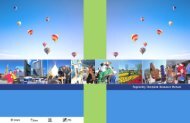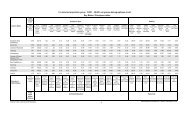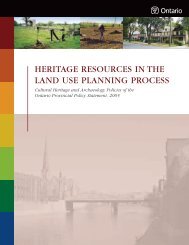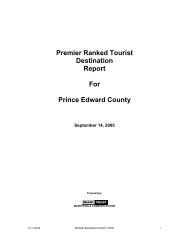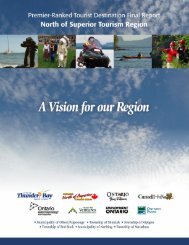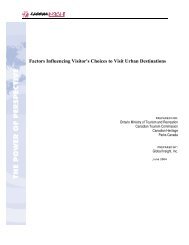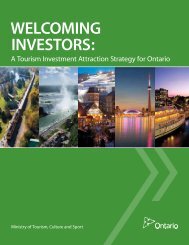Management Guidelines For Forestry and Resource-Based Tourism
Management Guidelines For Forestry and Resource-Based Tourism
Management Guidelines For Forestry and Resource-Based Tourism
- No tags were found...
Create successful ePaper yourself
Turn your PDF publications into a flip-book with our unique Google optimized e-Paper software.
<strong>Management</strong> <strong>Guidelines</strong> for <strong>For</strong>estry <strong>and</strong> <strong>Resource</strong>-<strong>Based</strong> <strong>Tourism</strong> – INTRODUCTIONIn addition, the MOU refers to ‘functionally roadless’<strong>and</strong> ‘reasonably similar level of remoteness’.They may be defined as follows:Functionally roadlessFunctionally roadless areas are areas where roads aregenerally discouraged <strong>and</strong> may be prohibited exceptfor forest management purposes.These roads are generally constructed to the lowestst<strong>and</strong>ard possible (e.g. tertiary roads, winter roads),routed to facilitate decommissioning, <strong>and</strong>/or restrictedto specific activities <strong>and</strong> uses. These functionally roadlessareas would normally be maintained to provide for, <strong>and</strong>promote, a tourism value that may be negativelyaffected by permanent, public road access.Reasonably similar level of remotenessParties agree in RSA negotiations to apply prescriptionsto protect specific tourism values. Where the tourismoperator has identified remoteness as a value to be protected,then the prescriptions identified in the tourismguidelines shall be applied to maintain a reasonablysimilar level of remoteness as existed prior to forest managementoperations. The prescriptions to be consideredwill include, but are not limited to: no harvest areas;functionally roadless strategies; modified operations.* Excerpt from <strong>Tourism</strong> <strong>and</strong> <strong>For</strong>estry Industry MOU 2001<strong>For</strong> example, if agreed to in an RSA, a tourism valuehas the same level of remoteness at the end of a fiveyearforest management plan term as it did at thebeginning of the same term.A reasonably similar level of remoteness is where thetourism value involved, has the same level of remotenesson the ending benchmark date as on the beginningbenchmark date. The beginning benchmark dateis a date agreed by the parties. It may be the beginningdate of the five-year term of the next FMP, or someother date, but cannot be earlier than the date the RSAis signed. The ending benchmark date is any later dateagreed by the parties. It may be the ending date of theFMP term, or some other date.Remoteness means accessibility; in other words, accessto the value should be limited to the same methods<strong>and</strong> be similarly easy or difficult on the ending date asit was on the beginning date.Most resource-based tourism values require touristoperator identification <strong>and</strong> range in their value orimportance according to the success of the business theysupport. In considering what is an important value, theessential question is: which resource features are importantto the enjoyment of the experience sought? Theseinclude not only specific resources of interest to tourists(e.g. high quality fishery, abundant wildlife, etc.) but alsothe conditions under which the experience is enjoyed(e.g. remoteness, water quality, healthy ecosystems,surrounding scenery <strong>and</strong>, accessibility).<strong>Resource</strong>-based tourism values may also be time specificfrom a seasonal or daily perspective. <strong>For</strong> instance,a fish or hunting resource may be very important to aresource-based tourism establishment however, it canonly be used while the resource is legally ‘in season’ orwhen the success rate of securing the resource is high(e.g. generally, speckled trout <strong>and</strong> or lake trout fishingsuccess is much higher in the spring <strong>and</strong> fall – not inthe summer months). Other values may only be usedduring a portion of a day, such as a hiking trail or alake used for fishing or viewing wildlife, but not forovernight excursions.Part of the RSA <strong>and</strong> FMP process is mapping theresource-based tourism values. "Criteria for mappingresource-based tourism values" found in the Guide to<strong>Resource</strong> Stewardship Agreements (2001) has beenproduced to assist the RSA process. It may also assistthe FMP process. It describes in detail what resourcebasedtourism values will be mapped by MNR .1.3.2 A New Approach To Protecting<strong>Resource</strong>-<strong>Based</strong> <strong>Tourism</strong> ValuesManaging the resource-based tourism/forestry interfacecan be a challenge. When the forest <strong>and</strong> resourcebasedtourism industries enter into discussions regardingfuture forest operations around resource-basedtourism facilities, both industries are dealing with mattersof significant value to their operations.Experience has shown that parties may move quicklyto establish what is necessary to protect their interestswithout fully underst<strong>and</strong>ing the other party’s interest.When this happens, meaningful discussions <strong>and</strong> negotiationsare often difficult, time consuming, <strong>and</strong> maynot be as successful for either party. Timely <strong>and</strong>4



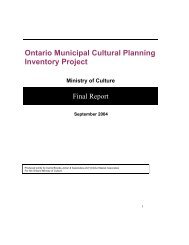
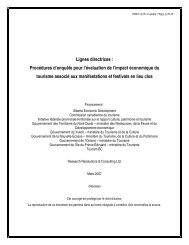
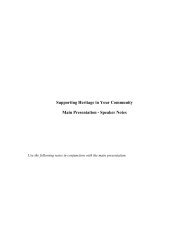
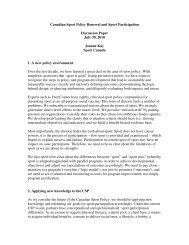
![THIS AGREEMENT made this [date], between [name of owner] (the ...](https://img.yumpu.com/49827605/1/158x260/this-agreement-made-this-date-between-name-of-owner-the-.jpg?quality=85)
